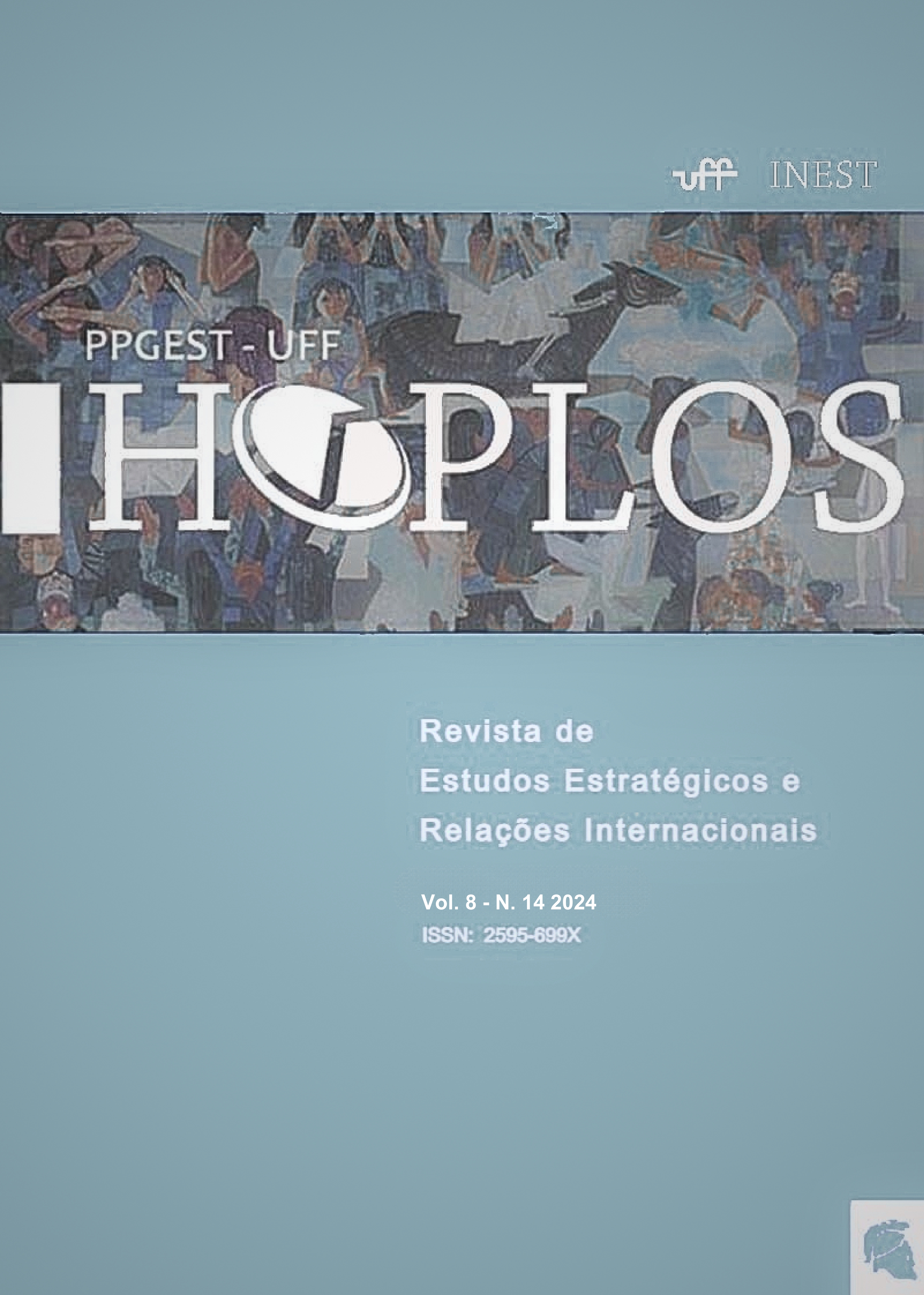AS IMPLICAÇÕES E OS DESAFIOS DA DEFESA CIBERNÉTICA EM REFERÊNCIA ÀS TECNOLOGIAS EMERGENTES
Palabras clave:
Segurança, Tecnologias, Ciberespaço, DefesaResumen
Como as tecnologias emergentes aumentam as vulnerabilidades cibernéticas? O presente artigo tem como objetivo refletir sobre os desafios associados à utilização de novas tecnologias na defesa cibernética. Assim, este trabalho propõe um estudo exploratório que examina o rápido desenvolvimento das tecnologias emergentes e sua aplicação na defesa cibernética. O estudo é conduzido por meio de uma revisão bibliográfica abrangente, englobando teorias relevantes sobre o espaço cibernético, defesa cibernética e tecnologias emergentes. O artigo está estruturado em três seções distintas. A primeira seção explora as questões relacionadas à vulnerabilidade e ameaças no ciberespaço, delineando os desafios críticos enfrentados nesse ambiente digital. Na segunda seção, são examinados os conceitos fundamentais das tecnologias emergentes, destacando suas potenciais aplicações e implicações na segurança cibernética. Por fim, a terceira seção investiga os desafios específicos e as implicações decorrentes da integração dessas tecnologias no espaço cibernético, ao oferecer uma análise aprofundada de seu impacto e relevância para a defesa cibernética contemporânea.
Descargas
Citas
ASSIS, A. C. de O.; BITTENCOURT, N. V.; TAVARES, S. M. B. Armas inteligentes no ciberespaço: oportunidades inovadoras e desafios prementes. Revista Brasileira de Estudos de Defesa, [S. l.], v. 7, n. 2, 2021. DOI: 10.26792/rbed.v7n2.2020.75211. Disponível em: https://rbed.abedef.org/rbed/article/view/75211. Acesso em: 27 maio 2024.
ATZORI, L.; IERA, A.; MORABITO, G. The internet of things: A survey. Computer networks, v. 54, n. 15, p. 2787-2805, 2010. Disponível em: chrome- extension://efaidnbmnnnibpcajpcglclefindmkaj/https://www.cs.mun.ca/courses/cs6910/IoT- Survey-Atzori-2010.pdf. Acesso em: 5 de maio 2023.
AYRES PINTO, D.; FREITAS, R. V.; PAGLIARI, G. 2019. Fronteiras virtuais: Um debate sobre segurança e soberania do Estado. In: Danielle Jacon Ayres Pinto, Maria Freire e Daniel Chaves (eds). Fronteiras Contemporâneas Comparadas: Desenvolvimento, Segurança e Cidadania. Macapá: Editora da Universidade Federal do Amapá, pp. 39-52, 2019.
BOYACK, K.; SMALL, H.; KLAVANS, R. Improving the accuracy of co-citation clustering using full text. Journal of the American Society for Information Science and Technology, vol. 64, n. 9, p. 1759-1767, 2013. Disponível em: https://onlinelibrary.wiley.com/doi/abs/10.1002/asi.22896. Acesso em: 5 de junho 2023.
BRESNIKER, Kirk et al. Grand challenge: Applying artificial intelligence and machine learning to cybersecurity. IEEE explore, v. 52, n. 12, p. 45-52, 2019. Disponível em: https://ieeexplore.ieee.org/document/8909930?utm_source=researcher_app&utm_medium=re ferral&utm_campaign=RESR_MRKT_Researcher_inbound. Acesso em: 15 de junho 2023.
BRUNDAGE, Miles et al. The malicious use of artificial intelligence: Forecasting, prevention, and mitigation. arXiv preprint arXiv:1802.07228, 2018. Disponível em: https://www.researchgate.net/publication/323302750_The_Malicious_Use_of_Artificial_Intel ligence_Forecasting_Prevention_and_Mitigation. Acesso em: 1 de abril 2023.
BRUNNER, T. Cybersecurity in beyond 5G: use cases, current approaches, trends, and challenges. Communication Systems XIV, p. 28, 2021. Disponível em: chrome- extension://efaidnbmnnnibpcajpcglclefindmkaj/https://files.ifi.uzh.ch/CSG/teaching/FS21/IFI _2021_02.pdf. Acesso em: 13 de abril 2023.
BURGELMAN, R. A.; ROSENBLOOM, R. S. Technology strategy: an evolutionary process perspective. Research on technological innovation, management and policy, v. 4, n. 1, p. 1-23, 1989. Disponível em: https://www.econbiz.de/Record/technology-strategy-an-evolutionary- process-perspective-burgelman-robert/10001090017. Acesso em: 15 de abril de 2023.
BUZAN, B.; WÆVER, O.; DE WILDE, J. Security: A new framework for analysis. Lynne Rienner Publishers, 1998.
CABAJ, Krzysztof et al. Cybersecurity: trends, issues, and challenges. EURASIP Journal on Information Security, vol. 10, n. 1, 2018. Disponível em: https://jis-eurasipjournals.springeropen.com/articles/10.1186/s13635-018-0080-0#citeas. Acesso em: 15 de abril de 2023.
CALDERON, R. The benefits of artificial intelligence in cybersecurity. Economic Crime Forensics Capstones, n. 36, 2019. Disponível em: https://digitalcommons.lasalle.edu/ecf_capstones/36/. Acesso em: 25 de abril de 2023.
CAVELTY, Myriam Dunn. The Militarisation of Cyber Security as a Source of Global Tension: strategic trends analysis. Strategic Trends Analysis, [s. l], p. 103-124, 18 fev. 2012. Disponível em: https://papers.ssrn.com/sol3/papers.cfm?abstract_id=2007043. Acesso em: 27 maio 2024.
CHOUCRI, Nazli. Cyberpolitics in International Relations. London: The Mit Press, 2012. 320 p. Disponível em: https://mitpress.mit.edu/9780262517690/cyberpolitics-in- international-relations/. Acesso em: 25 de julho de 2023.
DANIEL et al. Technical Assessment of Residential and Small Commercial Emerging Technologies. San Francisco, CA: Pacific Gas & Electric Company, 1998.
DAY, G. S.; SCHOEMAKER, P. J. H. Avoiding the pitfalls of emerging technologies. California management review, v. 42, n. 2, p. 8-33, 2000. Disponível em: https://www.researchgate.net/publication/243768097_Avoiding_the_Pitfalls_of_Emerging_T echnologies. Acesso em: 20 de junho 2023.
DENNIS, R.; OWEN, G. Rep on the block: A next generation reputation system based on the blockchain. In: 2015 10th International Conference for Internet Technology and Secured Transactions (ICITST). IEEE, 2015. p. 131-138. Disponível em: https://ieeexplore.ieee.org/document/7412073. Acesso em: 10 de junho 2023.
DOCHERTY, B. L. Heed the Call: A Moral and Legal Imperative to Ban Killer Robots. [s.l.] Human Rights Watch, 2018. Disponível em: https://books.google.com.br/books/about/Heed_the_Call.html?id=4QNcuwEACAAJ&redir_e sc=y. Acesso em: 24 de abril 2023.
DOUZET, F. La géopolitique pour comprendre le cyberespace. Hérodote, [S.L.], v. 152-153, n. 1, p. 3-21, 1 jun. 2014. CAIRN. http://dx.doi.org/10.3917/her.152.0003. Disponível em: https://www.cairn-int.info/article-E_HER_152_0003--understanding-cyberspace-with- geopolitic.htm. Acesso em: 25 abr. 2023.
ESPOSITO, Christian et al. Blockchain: A panacea for healthcare cloud-based data security and privacy?. IEEE cloud computing, v. 5, n. 1, p. 31-37, 2018. Disponível em: https://ieeexplore.ieee.org/document/8327543. Acesso em: 29 de abril 2023.
FANNING, K.; CENTERS, D. P. Blockchain and its coming impact on financial services. Journal of Corporate Accounting & Finance, v. 27, n. 5, p. 53-57, 2016. Disponível em: https://onlinelibrary.wiley.com/doi/10.1002/jcaf.22179. Acesso em: 30 de abril 2023.
FARHADI, M.; ISMAIL, R.; FOOLADI, M. Information and communication technology use and economic growth. PloS one, v. 7, n. 11, p. e48903, 2012. Disponível em: https://www.researchgate.net/publication/233419400_Information_and_Communication_Tec hnology_Use_and_Economic_Growth. Acesso em: 9 de maio 2023.
GLÄNZEL, W.; THIJS, B. Using ‘core documents’ for detecting and labelling new emerging topics.
Scientometrics, v. 91, n. 2, p. 399-416, 2012. Disponível em: chrome- extension://efaidnbmnnnibpcajpcglclefindmkaj/https://www.issi- society.org/proceedings/issi_2011/ISSI_2011_Proceedings_Vol1_26.pdf. Acesso em: 17 de junho 2023.
GOLDMAN, E. O.; ELIASON, L.C. The Diffusion of Military Technology and Ideas. Stanford University Press: Stanford, 2003. Disponível em: https://www.researchgate.net/publication/249909486_The_Diffusion_of_Military_Technolog y_and_Ideas_review. Acesso em: 17 de junho 2023.
GOMES, Julius et al. Cyber security business models in 5g. A Comprehensive Guide to 5G Security, p. 99-116, 2018. Disponível em: https://www.researchgate.net/publication/322466981_Cyber_Security_Business_Models_in_ 5G. Acesso em: 17 de junho 2023.
GRISSOM, A. The future of military innovation studies, Journal of Strategic Studies, 29 (5): 905–934, 2006. Disponível em: https://www.tandfonline.com/doi/abs/10.1080/01402390600901067. Acesso em: 17 de junho 2023.
GUPTA, M.; DUBEY, A. E-commerce-study of privacy, trust and security from consumer’s perspective. transactions, v. 37, p. 38, 2016. Disponível em: chrome- extension://efaidnbmnnnibpcajpcglclefindmkaj/https://www.ijcsmc.com/docs/papers/June201 6/V5I6201647.pdf. Acesso em: 17 de junho 2023.
HOEHN, J. R.; SAYLER, K. M. National Security Implications of Fifth Generation (5G) Mobile Technologies. Congressional Research Service (CRS) Reports and Issue Briefs, 2021. Disponível em: chrome- extension://efaidnbmnnnibpcajpcglclefindmkaj/https://crsreports.congress.gov/product/pdf/IF/ IF11251/5. Acesso em: 13 de junho 2023.
JAMES, A. D. Emerging technologies and military capability. Emerging critical technologies and security in the Asia-Pacific, p. 6-21, 2016. Disponível em: chrome- extension://efaidnbmnnnibpcajpcglclefindmkaj/https://www.files.ethz.ch/isn/174574/Policy% 20Brief-Emerging%20Technologies%20and%20Military%20Capability.pdf. Acesso em: 13 de junho 2023.
KANIA, E. B.; VORNDICK, Wilson. Weaponizing Biotech: How China’s Military Is Preparing for a ‘New Domain of Warfare.’. Defense one, v. 14, 2019. Disponível em: https://www.defenseone.com/ideas/2019/08/chinas-military-pursuing-biotech/159167/. Acesso em: 19 de maio 2023.
KSHETRI, N. Can blockchain strengthen the internet of things?. IT professional, v. 19, n. 4, p. 68-72, 2017. Disponível em: chrome- extension://efaidnbmnnnibpcajpcglclefindmkaj/https://libres.uncg.edu/ir/uncg/f/N_Kshetri_C an_2017.pdf. Acesso em: 19 de maio 2023.
LEE, In. The Internet of Things for enterprises: An ecosystem, architecture, and IoT service business model. Internet of Things, v. 7, p. 100078, 2019. Disponível em: https://www.researchgate.net/publication/278902692_Ecosystem_business_models_for_the_I nternet_of_Things. Acesso em: 19 de maio 2023.
LEVY, S. Hackers: heroes of the computer revolution. Dell Publishing Co., 2001. Disponível em: chrome-extension://efaidnbmnnnibpcajpcglclefindmkaj/https://www.temarium.com/wordpress/wp- content/uploads/downloads/2011/12/Levy_S-Hackers-Heroes-Computer-Revolution.pdf. Acesso em: 19 de maio 2023.
MALIK, V.; SINGH, S. Security risk management in IoT environment. Journal of Discrete Mathematical Sciences and Cryptography, v. 22, n. 4, p. 697-709, 2019. Disponível em: https://www.informahealthcare.com/doi/permissions/10.1080/09720529.2019.1642628?scroll =top. Acesso em: 19 de maio 2023.
MANDAL, Kumar; SINGHAL, Nikita; TYAGI, Deepak. Cybersecurity in the Era of Emerging Technology. In: KUMAR, Puneet et al. Emerging Technology and Management Trends. Delhi: Manglam Publications, 2023. Cap. 7. p. 98-124. Disponível em: ttps://www.researchgate.net/profile/Satish-Kumar- 345/publication/372953153_Emerging_Technology_and_Management_Trends/links/64d0d12 9806a9e4e5cf6158c/Emerging-Technology-and-Management-Trends.pdf#page=108. Acesso em: 12 janeiro 2024.
MANDARINO JR, R. Segurança e defesa do espaço cibernético brasileiro. Recife: Cubzac, 2010.
MANZANO, J.; OLIVEIRA, J. Algoritmos: lógica para desenvolvimento de programação de computadores, 28 ed. São Paulo: ética, 2016. Disponível em: https://www.academia.edu/23834458/Algoritmos_Manzano. Acesso em: 30 de maio 2023.
MILLER, J., Green, I., Putland, G. Emerging Technologies: A Framework for Thinking. Australian Capital Territory Department of Education and Training, 2005. Disponível em: chrome- extension://efaidnbmnnnibpcajpcglclefindmkaj/https://www.researchgate.net/profile/George_ Veletsianos/publication/235939794_A_Definition_of_Emerging_Technologies_for_Educatio n/links/550895120cf26ff55f8373a8/A-Definition-of-Emerging-Technologies-for- Education.pdf. Acesso em: 30 de maio 2023.
NSCAI, National Security Commission on Artificial Intelligence, “First Quarter Recommendations”, March 2020. Disponível em: https://www.nscai.gov/wp- content/uploads/2021/01/NSCAI-First-Quarter-Recommendations.pdf. Acesso em: 30 de maio 2023.
NAKAMOTO, S. Bitcoin: A peer-to-peer electronic cash system. Decentralized business review, 2008. Disponível em: chrome- extension://efaidnbmnnnibpcajpcglclefindmkaj/https://bitcoin.org/bitcoin.pdf. Acesso em: 30 de maio 2023.
NURSE, J.; CREESE, S.; DE ROURE, D. Security risk assessment in Internet of Things systems. IT professional, v. 19, n. 5, p. 20-26, 2017. Disponível em: https://www.researchgate.net/publication/318789039_Security_Risk_Assessment_in_Internet _of_Things_Systems. Acesso em: 5 de maio 2023.
O’NEILL, Maire et al. Insecurity by design: Today’s IoT device security problem. Engineering, v. 2, n. 1, p. 48-49, 2016. Disponível em: https://www.researchgate.net/publication/301827951_Insecurity_by_Design_Today's_IoT_De vice_Security_Problem. Acesso em: 5 de maio 2023.
OTAN. Allied Joint Doctrine for Cyberspace Operations. 2020. Disponível em: https://assets.publishing.service.gov.uk/government/uploads/system/uploads/attachment_data/ file/899678/doctrine_nato_cyberspace_operations_ajp_3_20_1_.pdf. Acesso em: 12 de jun. 2023.
OTAN. Emerging and disruptive technologies. OTAN, 2023. Disponível em: https://www.nato.int/cps/en/natohq/topics_184303.htm. Acesso em: 8 de jun. de 2023.
PANARELLO, Alfonso et al. Blockchain and IoT integration: A systematic survey. Sensors, v. 18, n. 8, p. 2575, 2018. Disponível em: https://www.researchgate.net/publication/326868072_Blockchain_and_IoT_Integration_A_S ystematic_Survey. Acesso em: 5 de maio 2023.
PATIL, P. Artificial intelligence in cybersecurity. International journal of research in computer applications and robotics, v. 4, n. 5, p. 1-5, 2016. Disponível em: https://www.academia.edu/25349174/ARTIFICIAL_INTELLIGENCE_IN_CYBER_SECUR ITY. Acesso em: 5 de maio 2023.
POHLE, J.; VOELSEN, D. Centrality and power. The struggle over the techno‐political configuration of the Internet and the global digital order. Policy & Internet, v. 14, n. 1, p. 13- 27, 2022. https://doi.org/10.1002/poi3.296. Disponível em: https://onlinelibrary.wiley.com/doi/10.1002/poi3.296. Acesso em: 10 de maio 2023.
POOLE, D. L.; MACKWORTH, A. K. Artificial Intelligence: foundations of computational agents. Cambridge University Press, 2010. https://doi.org/10.1017/9781108164085.
PORTELA, L. S. Geopolítica do espaço cibernético e o poder: o exercício da soberania por meio do controle. Revista Brasileira de Estudos de Defesa, v. 5, n. 1, 2018. Disponível em: https://rbed.abedef.org/rbed/article/view/75081. Acesso em: 1 de junho 2023.
RAJASEKAR, V.; PREMALATHA, J.; SARACEVIC, M. Cybersecurity in 5G and IoT Networks. Secure Communication for 5G and IoT Networks, p. 29-46, 2022. Disponível em: https://www.researchgate.net/publication/355726630_Cybersecurity_in_5G_and_IoT_Networ ks. Acesso em: 1 de junho 2023.
RID, Thomas. Cyber war will not take place. In: MAHNKEN, Thomas; MAIOLO, Joseph (ed.). Strategic Studies: A Reader. London: Routledge, 2014. p. 21. Disponível em: https://www.taylorfrancis.com/books/edit/10.4324/9781315814803/strategic-studies-thomas- mahnken-joseph-maiolo?refId=0f321b67-5e5f-4437-aa37-69adcdc9239f&context=ubx. Acesso em: 25 ago. 2023.
ROTOLO, D.; HICKS, D.; MARTIN, B. R. What is an emerging technology?. Research policy, v. 44, n. 10, p. 1827-1843, 2015. Disponível em: https://www.researchgate.net/publication/272164853_What_Is_an_Emerging_Technology. Acesso em: 1 de junho 2023.
SCHARRE, P. Autonomous weapons and operational risk. 2016. Disponível em: chrome- extension://efaidnbmnnnibpcajpcglclefindmkaj/https://s3.amazonaws.com/files.cnas.org/docu ments/CNAS_Autonomous-weapons-operational-risk.pdf. Acesso em: 1 de junho 2023.
SCHARRE, P.; LAMBERTH, M. Artificial Intelligence and Arms Control. arXiv preprint arXiv:2211.00065, 2022. Disponível em: https://www.researchgate.net/publication/364987994_Artificial_Intelligence_and_Arms_Cont rol. Acesso em: 1 de junho 2023.
SHA, Kewei et al. On security challenges and open issues in Internet of Things. Future generation computer systems, v. 83, p. 326-337, 2018. Disponível em: https://www.sciencedirect.com/science/article/abs/pii/S0167739X17324883. Acesso em: 5 de junho 2023.
SHARMA, A.; JHA, R. K. A comprehensive survey on security issues in 5G wireless communication network using beamforming approach. Wireless Personal Communications, 2021. Disponível em: https://dl.acm.org/doi/abs/10.1007/s11277-021-08416-0. Acesso em: 5 de junho 2023.
SICARI, Sabrina et al. Security, privacy and trust in Internet of Things: The road ahead. Computer networks, v. 76, p. 146-164, 2015. Disponível em: https://www.researchgate.net/publication/270107935_Security_privacy_and_trust_in_Internet _of_Things_The_road_ahead. Acesso em: 5 de junho 2023.
SCHMITT, Olivier. Defence as War. In: GALBREATH, David J.; DENI, John R. (ed.). ROUTLEDGE HANDBOOK OF DEFENCE STUDIES. London: Routledge, 2018. Cap. 2. p. 18-28. Disponível em: https://www.routledge.com/Routledge-Handbook-of-Defence- Studies/Galbreath-Deni/p/book/9780367514532 . Acesso em: 5 de junho 2022.
SRINIVASAN, R. Sources, characteristics and effects of emerging technologies: Research opportunities in innovation. Industrial Marketing Management, v. 37, n. 6, p. 633-640, 2008. Disponível em: https://www.researchgate.net/publication/222535627_Sources_Characteristics_and_Effects_o f_Emerging_Technologies_Research_Opportunities_in_Innovation. Acesso em: 5 de junho 2023.
STIENNON, R. A short history of cyber warfare. In: GREEN, James A. (ed.). Cyber Warfare: a multidisciplinary analysis. [S.I]: Routledge, 2015. p. 7-33.
STOICA, Ion et al. A berkeley view of systems challenges for AI. arXiv preprint arXiv:1712.05855, 2017. Disponível em: chrome- extension://efaidnbmnnnibpcajpcglclefindmkaj/https://sands.kaust.edu.sa/classes/CS290E/F1 9/papers/berkeley-sysai.pdf. Acesso em: 5 de junho 2023.
TEIXEIRA JÚNIOR, A. W. M.; LOPES, G. V.; FREITAS, M. T. D. As três tendências da guerra cibernética: novo domínio, arma combinada e arma estratégica. Carta Internacional, [S.
l.], v. 12, n. 3, p. 30–53, 2017. DOI: 10.21530/ci.v12n3.2017.620. Disponível em: https://www.cartainternacional.abri.org.br/Carta/article/view/620. Acesso em: 27 de junho 2023.
VALERIANO, B.; MANESS, R. C. Cyber war versus cyber realities: Cyber conflict in the international system. Oxford University Press, USA, 2015. Disponível em: chrome- extension://efaidnbmnnnibpcajpcglclefindmkaj/http://www.brandonvaleriano.com/uploads/8/ 1/7/3/81735138/cyber_war_versus_book_review_itp.pdf. Acesso em: 5 de junho 2023.
VERMA, S.; GUPTA, N. Application of Artificial Intelligence in Cybersecurity. Innovations in Computer Science and Engineering: Proceedings of 7th ICICSE, p. 65-72, 2020. Disponível em: https://www.researchgate.net/publication/339646771_Application_of_Artificial_Intelligence_ in_Cybersecurity. Acesso em: 30 de junho 2023.
WORK, R. O.; BRIMLEY, S. Preparing for war in the robotic age. Center for a New American Security, Washington, DC, Tech. p. 28, 2014. Disponível em: chrome- extension://efaidnbmnnnibpcajpcglclefindmkaj/https://www.files.ethz.ch/isn/176455/CNAS_ 20YY_WorkBrimley.pdf. Acesso em: 30 de junho 2023.
YAMPOLSKIY, R. V.; SPELLCHECKER, M. S. Artificial intelligence safety and cybersecurity: A timeline of AI failures. arXiv preprint arXiv:1610.07997, 2016. Disponível em: https://www.researchgate.net/publication/309424933_Artificial_Intelligence_Safety_and_Cyb ersecurity_a_Timeline_of_AI_Failures. Acesso em: 30 de junho 2023.
YEDUGONDLA, V. Implications of Emerging Technology on Cyber-Security. Risk Group, 2022. Disponível em: https://riskgroupllc.com/implications-of-emerging-technology-on-cyber- security/. Acesso em: 8 de jul. de 2023.
YLI-HUUMO, Jesse et al. Where is current research on blockchain technology?—a systematic review. PloS one, v. 11, n. 10, 2016. Disponível em: https://journals.plos.org/plosone/article?id=10.1371/journal.pone.0163477. Acesso em: 30 de junho 2023.
YOUSAF, Faqir et al. NFV and SDN—Key technology enablers for 5G networks. IEEE Journal on Selected Areas in Communications, v. 35, n. 11, p. 2468-2478, 2017. Disponível em: https://arxiv.org/abs/1806.07316. Acesso em: 30 de junho 2023.
##submission.downloads##
Publicado
Cómo citar
Número
Sección
Licencia
Derechos de autor 2024 Rachel Soares, Rebeca Rabêlo

Esta obra está bajo una licencia internacional Creative Commons Atribución-NoComercial-CompartirIgual 4.0.
1. PROPOSTA DE POLÍTICA PARA PERIÓDICOS DE ACESSO LIVRE
Autores que publicam nesta revista concordam com os seguintes termos:
a. Autores mantém os direitos autorais e concedem à revista o direito de primeira publicação, com o trabalho simultaneamente licenciado sob a Licença Internacional Creative Commons Attribution - Share Alike 4.0 que permite o compartilhamento do trabalho com reconhecimento da autoria e publicação inicial nesta revista.
b. Autores têm autorização para assumir contratos adicionais separadamente, para distribuição não-exclusiva da versão do trabalho publicada nesta revista (ex.: publicar em repositório institucional ou como capítulo de livro), com reconhecimento de autoria e publicação inicial nesta revista.
c. Autores têm permissão e são estimulados a publicar e distribuir seu trabalho online (ex.: em repositórios institucionais ou na sua página pessoal) a qualquer ponto antes ou durante o processo editorial, já que isso pode gerar alterações produtivas, bem como aumentar o impacto e a citação do trabalho publicado (Veja O Efeito do Acesso Livre).








